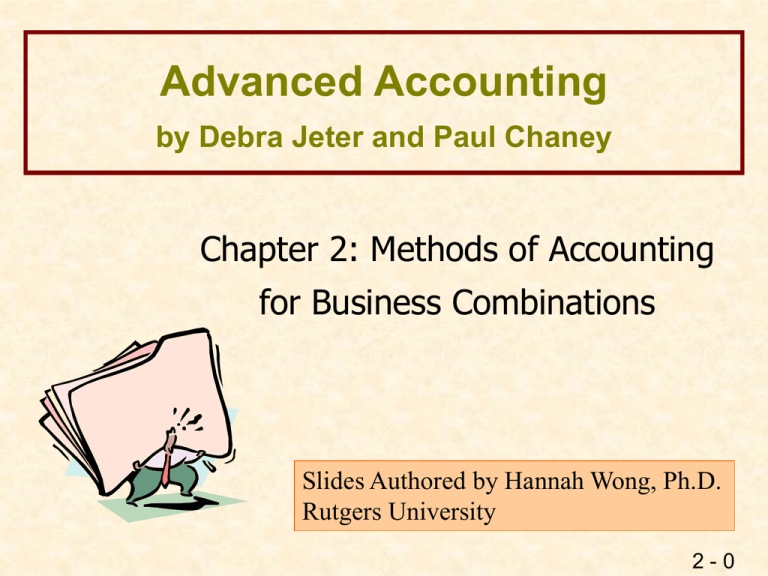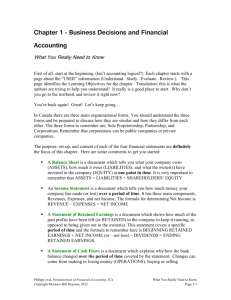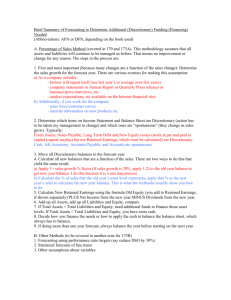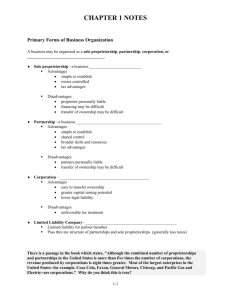
Advanced Accounting
by Debra Jeter and Paul Chaney
Chapter 2: Methods of Accounting
for Business Combinations
Slides Authored by Hannah Wong, Ph.D.
Rutgers University
2-0
Accounting Methods for
Business Combinations
Purchase Method
treats
the combination as the
purchase of one or more
companies by another.
Pooling of Interests Method
treats
the combination as two or more groups
of stockholders uniting their ownership
interests by an exchange of common stock.
2-1
Comparison of Purchase and
Pooling of Interests
Purchase
Assets and liabilities
acquired are recorded
at their fair values.
Any excess of cost over
fair value of net assets
acquired is recorded as
goodwill.
Pooling of Interests
Assets and liabilities are
recorded at their
precombination book
values.
No excess of cost over
book value exists, and
no new goodwill is
recorded
2-2
Comparison of Purchase and
Pooling of Interests
Purchase
Pooling of Interests
The acquired company’s
The acquired company’s
retained earnings are
not added into the
acquiring company’s
retained earnings.
Equity securities issued
are recorded at their
fair market value.
retained earnings are
added into the acquiring
company’s retained
earnings.
Equity shares issued are
recorded at the book
value of the acquired
shares.
2-3
Comparison of Purchase and
Pooling of Interests
Purchase
The excess of cost over
book value is
depreciated or
amortized to reduce
future earnings.
The acquired company’s
earnings are included
with the acquiring firm’s
only from the date of
combination forward.
Pooling of Interests
There is no additional
depreciation or
amortization expense.
The issuer and
combiner companies’
earnings are combined
for the full fiscal year in
which the combination
occurs.
2-4
Comparison of
Purchase and Pooling of Interests
Purchase
Pooling of Interests
Direct costs are
capitalized as part of
the acquisition cost.
Direct costs are
expensed in the year in
which incurred.
Indirect costs are
expensed.
Indirect costs are
expensed.
Security issuance costs
are deducted from
Security issuance costs
are expensed.
additional paid-in
capital.
2-5
Acquisition Costs - An Illustration
Facts:
SMC
Company acquires 100% of the net
assets of Bee Company by issuing shares
of common stock with a fair value of
$120,000.
SMC
incurred:
$1,500 of accounting and consulting costs
$3,000 of stock issue costs
$2,000 monthly overhead cost for its mergers
department
2-6
Acquisition Costs - An Illustration
Pooling Accounting:
Accounting and Consulting Expense (Direct)
1,500
Merger Department Expense (Indirect)
2,000
Securities Issue Expense (Security Issue Costs)
3,000
Cash
6,500
Purchase Accounting:
Goodwill (Direct)
1,500
Merger Department Expense (Indirect)
2,000
Other Contributed Capital (Security Issue Costs)
3,000
Cash
6,500
2-7
Disadvantages of Pooling Method
Values given and received are ignored
in a negotiated transaction.
“Instant earnings” can result
from
sale of newly pooled assets that are
carried at their precombination low book
values, and
from
including precombination earnings of
other companies in the year of
combination.
2-8
Disadvantages of Purchase Method
Subjective - appraisal of assets
or stock values are necessary.
Inconsistent - accounting for one part
of the combined company on a fair
value and the other part of a historical
basis.
2-9
Pro Forma Statements
Financial statements “as if” the
combination had been consummated.
Functions
information in the planning
stages of the combination
provide
disclose
relevant information subsequent
to the combination
2 - 10
Disclosure Requirements
Purchase Method
notes
to financial statements
should include pro forma
information
in the year of combination
in the immediately preceding period if
comparative financial statements are presented
2 - 11
Disclosure Requirements
Pooling Method
financial
statements should be restated on
a pro forma basis for all years presented
notes
to financial statements should
include
disclosure that the statements of previously
separately firms have been combined
operating results of separate firms prior to the
combination
2 - 12
Purchase Example - Facts
On January 1, 2000, P Company acquired the
assets and assumed the liabilities of S
Company.
P Company gave one of its $15 par value
common shares for each share of S company
common stock.
P Company common stock has a fair value
per share of $48.
Refer to Illustration 2-4 for the companies
balance sheet information.
2 - 13
Purchase Example - Journal Entry
Cash and Receivables
Inventories
Land
Buildings & Equipment (Net)
Discount on Bonds Payable
Goodwill
Current Liabilities
Goodwill = Bonds Payable
excess
Common Stock
cost over
Other Contributed Capital
fair value
of
identifiable
assets
acquired
170,000
140,000
400,000
1,000,000
50,000
230,000
Identifiable
net assets
acquired are
recorded at
their market
value on the
acquisition
date
150,000
400,000
450,000
990,000
Common stock issued is recorded at
market value on the acquisition date
2 - 14
Equity Allocation in Pooling of
Interests - Case A
P issued shares with par value of $450,000
Other Contributed
Capital - S
$50,000
Common stock -S
$300,000
$300,000
Common Stock
-P
$750,000
$50,000
$100,000
Retained Earnings
-S
$140,000
$140,000
Other Contributed
Capital - P
$400,000
Retained Earnings
-P
$350,000
2 - 15
Journal Entry - Case A
Cash and Receivables
Inventories
Land
Buildings & Equipment
Other Contributed Capital
Accumulated Depreciation
Current Liabilities
Bonds Payable
Common Stock
Retained Earnings
Total shareholders’ equity of S
Company ($490,000) is carried
forward to P Company
180,000
100,000
120,000
900,000
100,000
net assets
acquired
are carried
forward at
their book
value
300,000
110,000
400,000
450,000
140,000
Par value of common stock issued
is recorded
2 - 16
Equity Allocation in Pooling of
Interests - Case B
P issued shares with par value of $800,000
Other Contributed
Capital - S
$50,000
Common stock -S
$300,000
$300,000
Common Stock
-P
$750,000
$50,000
$400,000
$50,000
Other Contributed
Capital - P
$400,000
Retained Earnings
-S
$140,000
$90,000
Retained Earnings
-P
$350,000
2 - 17
Journal Entry - Case B
Cash and Receivables
Inventories
Land
Buildings & Equipment
Other Contributed Capital
Accumulated Depreciation
Current Liabilities
Bonds Payable
Common Stock
Retained Earnings
Total shareholders’ equity of S
Company ($490,000) is carried
forward to P Company
180,000
100,000
120,000
900,000
400,000
net assets
acquired
are carried
forward at
their book
value
300,000
110,000
400,000
800,000
90,000
Par value of common stock issued
is recorded
2 - 18
Equity Allocation in Pooling of
Interests - Case C
P issued shares with par value of $330,000
Other Contributed
Capital - S
$50,000
Common stock -S
$300,000
$300,000
Common Stock
-P
$750,000
$30,000
Retained Earnings
-S
$140,000
$20,000
$140,000
Other Contributed
Capital - P
$400,000
Retained Earnings
-P
$350,000
2 - 19
Journal Entry - Case C
Cash and Receivables
Inventories
Land
Buildings & Equipment
Accumulated Depreciation
Current Liabilities
Bonds Payable
Common Stock
Other Contributed Capital
Retained Earnings
Total shareholders’ equity of S
Company ($490,000) is carried
forward to P Company
180,000
100,000
120,000
900,000
net assets
acquired
are carried
forward at
their book
value
300,000
110,000
400,000
330,000
20,000
140,000
Par value of common stock issued
is recorded
2 - 20
Equity Allocation in Pooling of
Interests - Case D
P issued shares with par value of $275,000
Other Contributed
Capital - S
$50,000
Common stock -S
$300,000
$275,000
Common Stock
-P
$750,000
$25,000
Retained Earnings
-S
$140,000
$50,000
$140,000
Other Contributed
Capital - P
$400,000
Retained Earnings
-P
$350,000
2 - 21
Pooling Example - Case D
Cash and Receivables
Inventories
Land
Buildings & Equipment
Accumulated Depreciation
Current Liabilities
Bonds Payable
Common Stock
Other Contributed Capital
Retained Earnings
Total shareholders’ equity of S
Company ($490,000) is carried
forward to P Company
180,000
100,000
120,000
900,000
net assets
acquired
are carried
forward at
their book
value
300,000
110,000
400,000
275,000
75,000
140,000
Par value of common stock issued
is recorded
2 - 22
Bargain Purchase
Bargain = Fair value of identifiable net assets acquired
Less: Purchase price
Valuation of Net Assets Acquired:
Current assets, long-term investments in marketable
securities, liabilities = fair value
Previously recorded goodwill = 0
Long-term assets = fair value - bargain allocation
(The bargain is allocated to long-term assets in proportion
to their fair value.)
Any remaining bargain is recorded as negative goodwill and
amortized over a maximum of 40 years.
2 - 23
Bargain Purchase - Example
Bargain = Fair value of identifiable net assets ($23,000)
- Purchase price ($17,000)
= $6,000
Building $4,500
Land $1,500
Current Assets
Buildings ($15,000-$4,500)
Land ($5,000-$1,500)
Liabilities
Cash
Current assets and liabilities
are recorded at fair value
5,000
10,500
3,500
2,000
17,000
Building and Land is recorded at
fair value minus allocated
bargain
2 - 24
Contingent Considerations
Contingencies based on earnings
Contingencies based on security prices
2 - 25
Earnings Contingency
Definition
additional
consideration to be made if the
combined company’s future earnings equal
or exceed a threshold.
Accounting Treatment
as
additional cost of acquisition
2 - 26
Stock Price Contingency
Definition
additional
consideration to be made if the
future market value of shares issued is less
than the guaranteed value
Accounting Treatment
no
effect on acquisition cost
as
an adjustment to Other Contributed
Capital
2 - 27
Leveraged Buyout (LBO)
A management group contributes stock they
hold and borrows funds to a create new
company, which acquires all the outstanding
common shares of their employer company.
2 - 28
Leveraged Buyout (LBO)
Borrowed Fund
Stock of employer
company held by
managers
New Company
acquires
Employer Company
2 - 29
Leveraged Buyout (LBO)
Valuation of New Company
net
assets acquired by borrowed fund
market value
net
assets contributed by managers
book value
2 - 30
Leveraged Buyout (LBO) Example
Valuation of Net Assets in New Company
Market Value
Excess cost applied to
Goodwill
plant assets = $13,500
$9,000
Book Value
$1,000
10%
Net assets
contributed
by managers
Excess
of cost
over
book
value
$9,000
90%
Net assets acquired
by borrowed fund
of $31,500
2 - 31
Criteria for Pooling of Interests
Company Attributes
autonomous
of any other companies
independent
of other combining companies
2 - 32
Criteria for Pooling of Interests
Exchange of Stock
single
transaction
common
stock for 90% common stock
no
change in equity interest
no
abnormal treasury stock transactions
same
ratio of interest of individual stockholders
voting
no
rights immediately exercisable
provision for future issuance of stock
2 - 33
Criteria for Pooling of Interests
Absence of Planned Transactions
no
agreement to reacquire stock
no
financial arrangements for shareholders
no
unusual disposal of assets
2 - 34
Advanced Accounting
by
Debra Jeter and Paul Chaney
Copyright © 2001 John Wiley & Sons, Inc. All rights reserved.
Reproduction or translation of this work beyond that permitted in Section 117 of
the 1976 United States Copyright Act without the express written permission of
the copyright owner is unlawful. Request for further information should be
addressed to the Permissions Department, John Wiley & Sons, Inc. The
purchaser may make back-up copies for his/her own use only and not for
distribution or resale. The Publisher assumes no responsibility for errors,
omissions, or damages, caused by the use of these programs or from the use
of the information contained herein.
2 - 35









